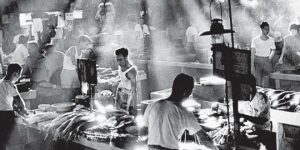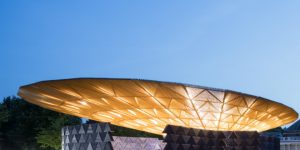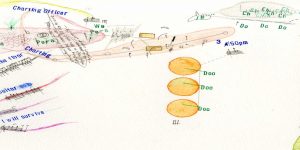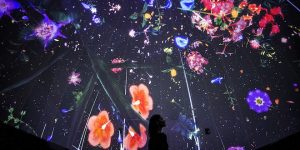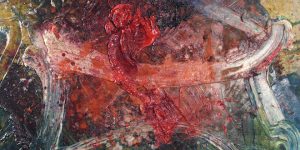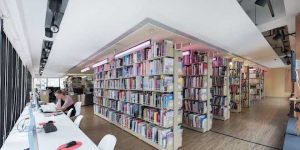Interview with Maryanto: Once Upon a Time in Rawalelatu
Indonesian artist Maryanto guides us into the unknown and unseeable globalisation abyss

Maryanto, ‘Story of Space’ (installation view), 2017
“They ARE violent! They will kidnap you!” Regales Maryanto, on friends’ response to his a recent attempt at a jaunt into the warlord-guarded oil rigs in Africa. “I’m like, yeah! You think so? Okay, let’s find someone who can bring us in.”
The exchange epitomises Indonesian artist Maryanto’s ethos — a visceral approach almost detective noir-esque, jumping into the abyss. Much of his work involves inserting himself into strange and prohibited lands (not through arbitrary bravado, but of a bottomless curiosity), and him bringing back its beauty, horror and tales for a people who live untouched by the hidden atrocities of globalisation. The body of Maryanto’s work revolves around the issues of poverty, pollution and exploitation, and its geopolitical and local human consequences. These are woven through a web of historical research, myths and stories into his own artistic vernacular and vision, then, more often than not, saturated (or desaturated) into massive, brooding, monolithic charcoal drawings that channels beauty and the apocalypse at the same time. “Maryanto makes art to engage in social and political activism,” states the first lines of any text about his work. More than anything, he knows as well, like good war photographers will attest, there is a kind of sublime beauty in absolute horror.

Maryanto, ‘Story of Space’ (installation view) 2017.
As he lays the finishing touches on his solo show ‘Maryanto: Story of Space’ at Yeo Workshop, Art Republik caught up with him in the afternoon to ruminate on his work, and his politics.
A lot of your work deals with political activism. Having spent your formative years, in Indonesia under the Suharto regime, how would you compare those times to the current political climate? Is Indonesia moving in a more positive direction under democratic rule, or do the same problems still persist?
I was born in 1977, under the Suharto era. Most of the artists then were working politically and fought the government. There was tremendous pressure from the regime on artists, and they were gagged from speaking politically. To speak means one is “clashing” with the authority.
It’s almost impossible to make art without talking about politics, about people.
The way we talk about politics is changing. After the regime collapsed, artists were able to speak freely, so talking about politics wasn’t “cool” anymore. Previously it was: wow, you’re a rebel! Now it’s different.
To speak politically is to speak about the now and the future, and not just about the people. These days, artists don’t clash with the government. We talk about why people do the things that they do. You asked whether things are getting better or worse in a democracy. That’s the big question now. When freedoms are given to the people, groups get competitive. Now artists face problems from “people’s” organisations and religious groups. If say, I speak on LGBT, on communism, they don’t like it. It’s been happening in Yogyakarta, with people coming to shows and demanding for it to be shut because one is talking about the communists.
Today, it isn’t face-offs with the government anymore, but people against people. So to talk about politics now really is about how to make others understand the situation.

Maryanto, ‘Observation No. 4’, 2015
Your work, much as they deal with universal problems of the globalised economy, are very intentionally idiosyncratic to Indonesia. What is it like living in Indonesia, specifically Yogyakarta? Does it influence you?
Yogyakarta is the place that I really love; so many artists live here. It is not a place for the industry but for education. You’d be meeting people all the time and they’d be like “hey, I’m also an artist!” There are so many young intellectuals based there as well.
It’s different from Singapore. Yogya feels like we have 30 hours a day since we are so relaxed! Not exactly laziness per se, but we just have a lot of time. It’s a small city and things are intuitive and spontaneous. We can go to a friend’s house and be working on a new thing in a snap, and people are always genuinely happy to receive you. It’s like a community or an art ecosystem. Everyone is connected: activists, intellectuals, artists.
That is enviously cool. It is known that you imbue your work with theatrical devices/staging, with the deliberate intention of framing stories. I feel like the considered use of charcoal to make your lush, almost cinematic artworks aren’t too different from a cinematographer choosing to colour a film with a certain palette. Are narratives and stories something you think about in your practice?
When I make a drawing, I imagine the audience right next to me. I try to bring to people what I feel and see. I create a stage. That’s the only thing I can do. I can never bring you to the places I have been; I can bring you to the place I can feel, so that’s the experience I can give you. A friend saw my work and said, “It’s a bit sad.” Yeah, it’s sad; that’s the feeling I had when I saw (the destructive mess, on location) it. It’s sublime at the same time. And ironic. And these are the things I want to tell.

Maryanto, ‘We Were There Beb’, 2016
Works like these (points to ‘Randu Belatung’), we were in Yogya visiting an oil facility in the jungle behind the mountain. The area was named Randu Belatung. “Latung” means oil, since the area was surrounded by an oil rig. That is why I made this a monstrous, creepy thing. It could be that someday, people won’t think about planting the trees anymore and just think about taking the oil. Pipelines will come and transform the place into a massive operation and forestry will permanently disappear. It is a story of a space, because some areas have stories behind them, and I try to convey these stories.
I digress but sometimes I think about this: Singapore and Hong Kong are the only developed places in this part of the tropics, while the others here aren’t. In advertising, you always see an idealised beautiful tropical locale, and when I went to Nigeria, Jakarta, wow, the tropical people are in a terrible state. They’re really struggling, and there is so much resistance to life for them; it is not a paradise, it’s not a shared colonial perspective of “a tropical wonderland”.
I think it’s a bit funny, when people say certain parts of Indonesia is a tropical paradise — it’s a completely man-made mirage: cherry-pick old traditions, repackage it with a ribbon under the rubric of “authenticity” (shorn of the messiness), while the the actual denizens have to put up with an actual “drag” interpretation of their culture sold back to them.
That is true. Much of this is due to colonialism.
Do you think your work as an artist, as opposed to journalistic and political intervention/investigation, allows for a more dialectic, more meditative approach?
I feel artists have freedoms to say big things with their intuition. They don’t need exact data; the artist can say something they feel. For example, in this exhibition, my thoughts were occupied by the utopian “ideal life”. To talk about utopia, I’ll also have to talk about dystopia. I always think utopia is close to nature and life. That’s why in the back of the gallery, I show nature in its beauty and spiritual splendour. And then in the front, you see all the problems, with people violently stripping Earth of its resources.
You like to deal with parables, and obvious, jarring elements that one wouldn’t easily associate together: personified animals living their provincial kitchensink lives to massive, hulking industrial machines that almost look like dystopian mecha-weapons of mass destruction raining death from above. Are dualities something that you think about, and what about it interests you?
I think everything is ironic. My work is black and white. Everything resides in a “grey area’’ or a graduation. On that spectrum, you can choose the position and the ideal life you want to live. The personified animals were a part of my exploration into urban life, so everybody is a character: the rabbit is a factory worker, the dog is a policeman who follows the leader. Recently, I was on a trip to South Korea. People there hold in esteem the mountains and the river. It’s got me wondering: a life spent slogging in the factory, you die and your family puts your remains back in the mountain, and it’s like you’re back with nature.
Why work so hard in the mechanised factory, and still yearn to return to nature at the end? We need to rethink our approach to life. It’s so easy to find on Facebook 30-second videos that claim to know all of life’s answers! People just need to think more about their lives. It might be out of your control now, but you should still think of it. I feel that is important to at least be aware.
This article was originally published in Art Republik.




